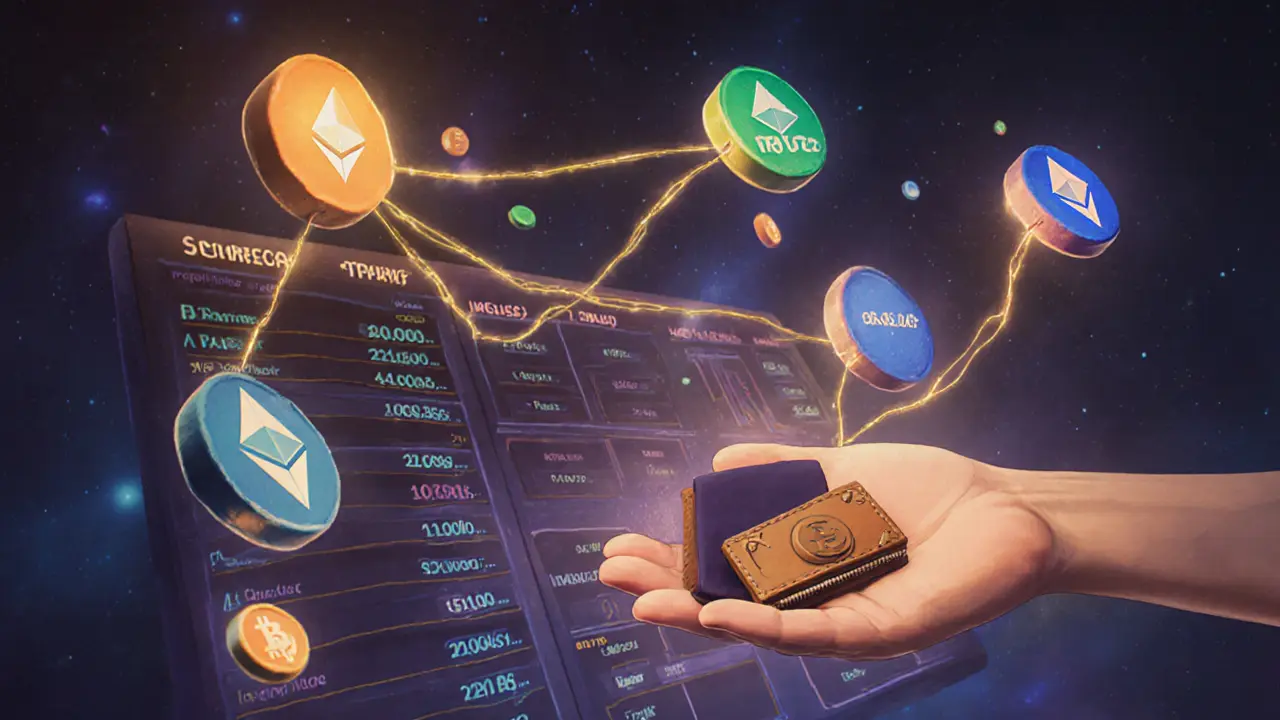Clober Crypto Exchange Review: The Only Fully On-Chain Order Book DEX That Actually Works
 Jun, 7 2025
Jun, 7 2025
Slippage Calculator
See how much slippage you'd face on Uniswap vs Clober for your trade.
What Is Clober Crypto Exchange?
Clober is a fully on-chain decentralized exchange (DEX) that uses a real limit order book-just like traditional stock exchanges-but runs entirely on blockchain smart contracts. Unlike Uniswap or SushiSwap, which rely on liquidity pools and automated pricing, Clober lets you place buy and sell orders at exact prices. Your funds never leave your wallet. No custodians. No middlemen. Just direct peer-to-peer trading on Ethereum and other EVM chains.
It launched in February 2023, built by an anonymous team, but its tech isn’t anonymous-it’s groundbreaking. The core innovation is called the LOBSTER algorithm (Limit Order Book with Segment Tree for Efficient oRder-matching). Before Clober, trying to run an order book on-chain meant paying $20-$50 per trade in gas fees. Clober cut that to $2-$3, making it practical for everyday traders.
How Clober Solves the Biggest Problem in DeFi
Most DEXs use Automated Market Makers (AMMs). They work fine for casual swaps, but they have serious flaws. If you provide liquidity on Uniswap, you risk impermanent loss-losing money just because prices moved. And if you want to buy 100 ETH at exactly $3,200, you’ll get slippage. You might end up paying $3,250 because the pool doesn’t have enough depth.
Clober fixes both. As a liquidity provider, you don’t lock funds in a pool. You place a limit order-say, sell 50 USDC at $0.99 each. If someone buys at that price, you get paid. If not, your money sits untouched. No impermanent loss. No forced exposure to volatile pairs.
For traders, it’s even better. You set your price. You get filled at that price. No slippage. No guessing. This matters most for stablecoins, large orders, or institutional traders who can’t afford random price jumps.
How Clober’s Technology Actually Works
The secret is in the segment tree data structure. Most on-chain order books store every single order, which bloats the blockchain and burns gas. Clober’s LOBSTER algorithm doesn’t do that. Instead, it tracks only the total amount claimable by each maker order. When a taker places a buy order, the system calculates matches instantly without writing every single trade to the chain.
This reduces the computational complexity from O(n) to O(log n). In plain terms: instead of checking every single order one by one, Clober finds matches in seconds, no matter how many orders are active.
Here’s how a trade flows:
- You place a limit sell order for 100 DAI at $1.01. It goes on-chain.
- Someone else places a market buy for 50 DAI. Clober matches it instantly.
- The buyer gets their DAI. You get your USDC.
- But here’s the catch: you have to manually claim your proceeds. The system doesn’t auto-deposit them.
This manual claiming step is intentional-it keeps gas costs low. But it’s also the biggest UX headache.

Pros and Cons: The Real Trade-Offs
Pros
- No impermanent loss for liquidity providers-your funds only get used when your exact price is hit.
- Zero slippage on limit orders. You get exactly the price you set.
- Gas costs are low-$2-$3 per trade on Ethereum, compared to $20+ on older on-chain order books.
- 100% capital efficiency. Your tokens aren’t locked in a pool across a price range. They sit idle until you’re ready to trade.
- Non-custodial. Your keys. Your coins. Always.
- Open-source. Code is on GitHub with 12 active contributors as of November 2023.
Cons
- Manual claiming. You have to go back and claim your filled orders. If you forget, your funds stay locked until you do. Some users automate this with scripts, but it’s not beginner-friendly.
- Limited token pairs. You won’t find obscure memecoins here. Clober focuses on major assets: ETH, USDC, DAI, WBTC, and a few others. Less than 50 pairs total.
- Not for high-frequency trading. If you’re scalping or using bots that execute hundreds of trades per minute, Clober isn’t for you. Ethereum’s block time (12 seconds) is too slow.
- Gas spikes hurt. During Ethereum congestion (gas > 100 gwei), fees can jump to $8. Still better than old DEXs, but worse than Layer 2s like Arbitrum or Optimism.
- Learning curve. If you’ve only used Uniswap, the order book interface feels foreign. Bid/ask spreads, order cancellation, and claiming mechanics take time to learn.
Clober vs Uniswap vs Serum: Who Wins?
| Feature | Clober | Uniswap | Serum |
|---|---|---|---|
| Type | Full on-chain order book | AMM (liquidity pools) | Hybrid (off-chain order book, on-chain settlement) |
| Slippage | None on limit orders | High on large trades | Low, but not zero |
| Impermanent Loss | None | Yes | None (but liquidity still pooled) |
| Gas Cost per Trade | $2-$3 (Ethereum) | $5-$15 | $0.50-$2 (Solana) |
| Capital Efficiency | 100% | Low (funds locked in ranges) | Medium (funds pooled) |
| Order Types | Limit, Market | Market only | Limit, Market, IOC, FOK |
| Censorship Resistance | Full on-chain | Full on-chain | Partial (off-chain matching) |
Clober wins on precision and capital efficiency. Uniswap wins on simplicity and token variety. Serum wins on speed and low fees-but it’s not fully decentralized. If you care about exact pricing and control, Clober is the only choice.
Who Should Use Clober?
Clober isn’t for everyone. But it’s perfect for:
- DeFi liquidity providers who hate impermanent loss and want to earn yield without risking price swings.
- Stablecoin traders who need to swap USDC for DAI at exactly $1.00, not $0.995 or $1.008.
- Institutional traders testing DeFi for large, low-slippage orders.
- Advanced users who are tired of AMMs and want real market control.
If you’re a beginner who just wants to swap ETH for DAI and go, stick with Uniswap. If you’re someone who tracks bid-ask spreads, sets price alerts, and hates unpredictable execution-Clober is your next tool.

Current Limitations and Future Roadmap
Clober’s biggest weakness right now is Ethereum’s gas costs. During peak times, trades can hit $8. That’s still cheaper than the old days, but not competitive with Layer 2s like Arbitrum or Base.
The team’s roadmap is clear:
- January 2024: Launch on Arbitrum and Optimism.
- Q1 2024: Institutional API for bots and hedge funds.
- Q2 2024: Multi-chain liquidity aggregation-pulling orders from multiple networks into one interface.
- 2025: Potential integration with Ethereum’s danksharding for even lower fees.
MakerDAO is already exploring Clober for precise DAI redemption pricing. That’s a big signal-this isn’t just a hobby project. It’s being adopted by serious DeFi protocols.
Community and Support
The community is small but passionate. On RootData, 82% of 2,997 voters are bullish. Reddit users complain about manual claiming, but also praise the lack of slippage. DEXTools shows a 4.2/5 rating across 127 reviews.
Support is slow-email replies take 8+ hours. But there’s an active Telegram group (4,200 members) and Discord (3,800 members) where users share automated claiming scripts. If you’re technical, you can write a simple script to auto-claim filled orders. If not, you’ll need to remember to check your wallet after each trade.
Final Verdict: Is Clober Worth It?
Clober isn’t the easiest DEX. It’s not the fastest. It doesn’t have hundreds of tokens. But it’s the only DEX that gives you the exact same trading experience as a centralized exchange-without giving up control of your funds.
If you’ve ever been burned by slippage on a big trade, or lost money to impermanent loss, Clober solves those problems. It’s not perfect. The claiming process is clunky. The interface isn’t polished. But the underlying tech? It’s revolutionary.
For DeFi users who value precision over convenience, Clober isn’t just another exchange. It’s the future of decentralized trading.
Ian Esche
November 25, 2025 AT 23:49Felicia Sue Lynn
November 27, 2025 AT 05:13Christina Oneviane
November 28, 2025 AT 08:44